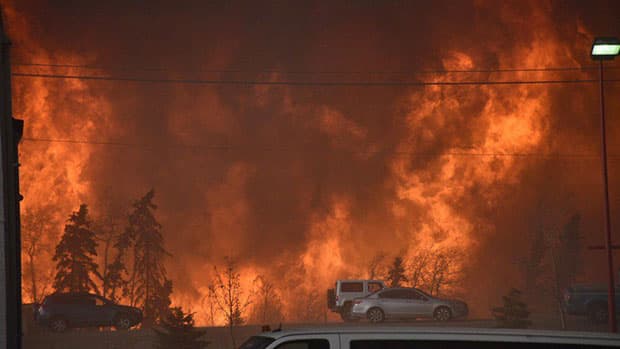Aided and Abetted by Humans, Wildfires are Torching Canada, California, the Planet
Published on May 19th, 2016
Ironies abound as a massive forest fire, nicknamed “the Beast,” recently brought tar sands production to a halt in the Canadian province of Alberta. It’s been more than two weeks since the Beast roared through Fort McMurray and its surroundings with 200-foot high flames destroying everything in their hellish path.
 As of May 13, the Beast had displaced about 94,000 from their homes, destroyed more than 2,000 structures, and burned almost 600,000 acres in total. The Beast is a behemoth even by California’s world-class wildfire standards. The largest wildfire in California history, the October 2003 Cedar Fire in San Diego County, burned 273,000 acres, destroyed 2,820 structures, and caused 15 deaths.
As of May 13, the Beast had displaced about 94,000 from their homes, destroyed more than 2,000 structures, and burned almost 600,000 acres in total. The Beast is a behemoth even by California’s world-class wildfire standards. The largest wildfire in California history, the October 2003 Cedar Fire in San Diego County, burned 273,000 acres, destroyed 2,820 structures, and caused 15 deaths.
The tar sands, or oil sands, as the Canadian oil industry prefers to call them, are Canada’s largest oil-producing resource. However, oil is produced here not by drilling but by mining bitumen, a tar-like substance, separating it from the clay, sand and water mixed in with it.
Mining bitumen and wringing oil out of it is a dirty, energy-intensive and highly polluting process. Exploiting Canada’s enormous Athabasca tar sands deposits destroys forest habitat and produces large amounts of air and water pollution, as well as greenhouse gases. Thus, it has inspired passionate opposition by environmentalists, Native Americans and climate change activists.
It is ironic, therefore, that a huge wildfire caused in part by manmade climate change has temporarily, at least, suspended a human activity that helps to drive this very climate change. Is Mother Earth – Gaia – fighting back? I don’t believe in such superstitions or magical thinking, but it’s certainly an intriguing notion.
The forest fires themselves are releasing gigantic quantities of carbon stored in the trees to the atmosphere as carbon dioxide. And more ominously, as reported in New Scientist, the fires may also be releasing carbon stored as frozen organic matter in permafrost.
.jpg) |
| The huge 2016 Fort McMurray wildfire known as the Beast stops highway traffic. |
I have written before for CAPS (see here and here) on the tightening nexus between overpopulation, wildfire and global warming, and the recent destruction in Canada, where I once lived, prompts renewed attention.
A recent blog post by Jeff Atkins in PLOS Ecology Community observes that ecologists and climatologists have been warning repeatedly for some time now that climate change will increase the incidence and size of wildfires. It is also widely accepted that human activity directly contributes to an increase in the frequency of wildfires.
A new study published in the online scientific journal PLOS ONE by geography professor Michael L. Mann of George Washington University and his colleagues found that incorporating human activity and demographics into fire probability models reduced the uncertainty of these models and demonstrated that the increased frequency of wildfires is partially attributable to humans.
The increase in wildfires is due both to human population growth and to the fact that more of us than ever before are building homes and communities in forested, fire-prone landscapes. Fire managers refer to the Wildland-Urban Interface (WUI), those zones on the edge where residential and other development intermingle with fire-prone habitats. Many fire and biodiversity conservation-related environmental conflicts are situated within the WUI.
 |
|
2014 King Fire burning in Eldorado National Forest
captured from space by NASA’s Aqua satellite.
|
California alone has more than five million houses located within WUIs in the state. This large number of structures has increased vulnerability to deadly and costly wildfires. From 1999 to 2011, California averaged $160 million a year in fire-related structural damage and destruction.
While climate change and weather are responsible for much of the severity of wildfires in California and elsewhere, in California, 95 percent of all wildfires are started by people. “From cigarettes tossed from moving cars, to campfires not properly extinguished, humans are clearly a major source of wildfire ignition,” writes Atkins.
Their increasing frequency is attested by the fact that, of the 10 largest California wildfires in history, seven have occurred just since 2000. The last two fire seasons have been among the worst in California history.
In a notorious recent case, Wayne Huntsman, who lit a fire to take a “fire selfie,” was fined $60 million and sentenced to 20 years in prison. The fire this egomaniac and pyromaniac ignited spread to become the 2014 King Fire in El Dorado County, which burned 100,000 acres. Many firefighters were injured in the fire which also destroyed 12 houses and more than 100 other buildings.
Wildland fires are now raging around the world, from Alaska to Asia to the Amazon, as the climate warms and many regions dry out. Moisture-stressed trees are attacked by insects and disease, and then become “fuel” for fires. These massive fires threaten not just human beings and our communities, but wildlife and wildlife habitat.
Humongous, deadly wildfires are yet another sign of a world out of balance.




